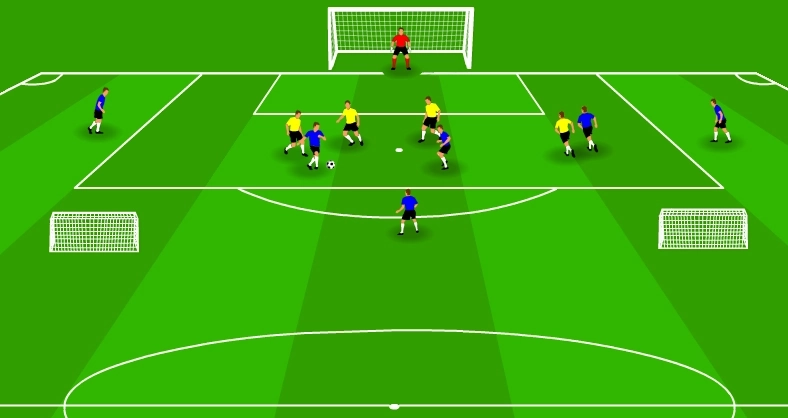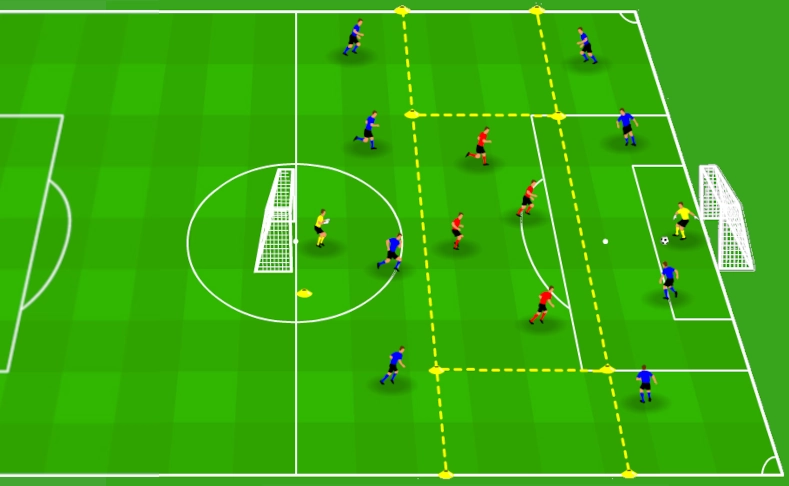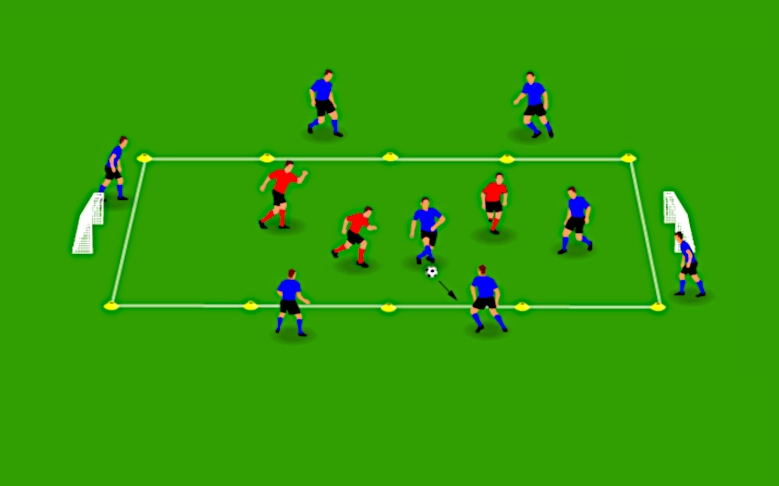Defending in the box drill

Defending in the box can be a risky business, but even good teams have to do it at some point during a game. This drill will help your defence to minimise mistakes when the ball is close to their goal.
Setup
This drill is a competitive game between your defenders and the rest of your team: 1 goalkeeper, 4 defenders and 6 attacking players. Therefore, you need half of an actual football pitch for this drill. If you have more than 16 players, organise two groups and use the other half of the field.
In addition to an actual field, you will need vests, balls and 2 small goals. If you can’t get hold of full pitch, find a park with enough space and use cones and agility poles to mark the playing field.
Instructions
This drill is a football game but in a reduced space close to the goal. All regular rules apply, including offside. In addition to the official football laws, follow these instructions:
- 2 teams: 1 goalkeeper, 4 players defend and 6 players attack.
- 4 defenders and 3 attacking players stay inside the penalty box. The can’t move outside the box.
- The 3 remaining attacking players stay outside the penalty area on each side of the box.
- Attacking players can pass the ball to the players outside the box to provide additional options. For example, cross the ball for a header.
- The players outside the box are only supporting players. Therefore, they cannot shoot at goal or move into the box.
- When the defenders recover the ball, they can score in the small goals.
- The goalkeeper can also score by kicking or sending the ball with his hands to one of the small goals.
- The outside player closer to the small goals can block the defenders’ attempts to score.
- Sliding tackles are not allowed, except for the attacking player protecting the small goals who can slide in order to block a ball travelling to one of the small goals.
- If a player breaks one of the rules above, a point is awarded to the opposite team.
- After 10 minutes, rotate the outside players with inside players.
- The team with the highest score wins.
Be creative and add your own rules. But, make sure to maintain the spirit of the drill. For example, you can limit the number of touches allowed once a player gets the ball.
Takeaways
The main objective of this drill is to defend inside the penalty area. Regularly practising this drill will minimise mistakes like reckless challenges, excessive force or handballs that can lead to a penalty. With the addition of small goals, this drill will encourage your defence to control the ball rather than hoof it away. However, because this drill is an actual football game, it will improve many aspects of your team’s game:
- Patience and defending close to the goal. Not allowing sliding tackles forces defenders to be patient and keep their position. Defenders practice how to recover the ball, avoiding reckless defending.
- Teamwork. This drill encourages collaboration over individual efforts. Players have to coordinate their movements to keep possession, move into scoring position in the right moment, and defend.
- Positioning. Players have to move on and off the ball to create passing lanes. When defending, players have to position themselves to close passing lanes and block shots.
- Accurate passing. Because the game is played in a reduced space, players must improve their passing technique to keep posession, find gaps in the opposition or transition from defence to attack.
- First touch. Because the game is played in a reduced space, players must improve their first touch to control and pass the ball or shoot.
- Shooting accuracy. Although improving your offensive players finishing is not the primary objective, practising with a goalkeeper and defenders requires attackers to read their movements and shoot with pinpoint accuracy.
- Quick finishing. Because this game is timed and the box is crammed with defenders, the faster players shoot, the better. If players are still taking considerable time to finish a play, introduce limited touches or passes.
- Crossing and long balls. Consistency is key in crossing. Crosses have to be timed and with the right power on them to avoid being intercepted but also to make them easy to control by the shooting player.
- Ball control. A great deal of control is required to quickly get the ball on the ground from airborne crosses and shoot.
- Headers and volleys. While players may choose to control the ball and then shoot if the ball comes from a cross, crossed balls will encourage headers and volleys.
- Timing and reaction. Once an attacking player shoots, other players must be ready to score or block a second chance at goal.
- Goalkeeping. This is an excellent drill for goalkeepers. They practice saving direct shots and crosses while controlling the ball as much as possible to avoid second chances. They also practice distributing the ball by aiming at the small goals.
I hope you find this drill helpful. If you like this post, please share it with your friends. If you know other exercises or have any questions, leave a comment below.



